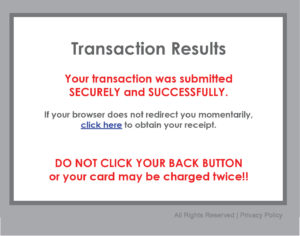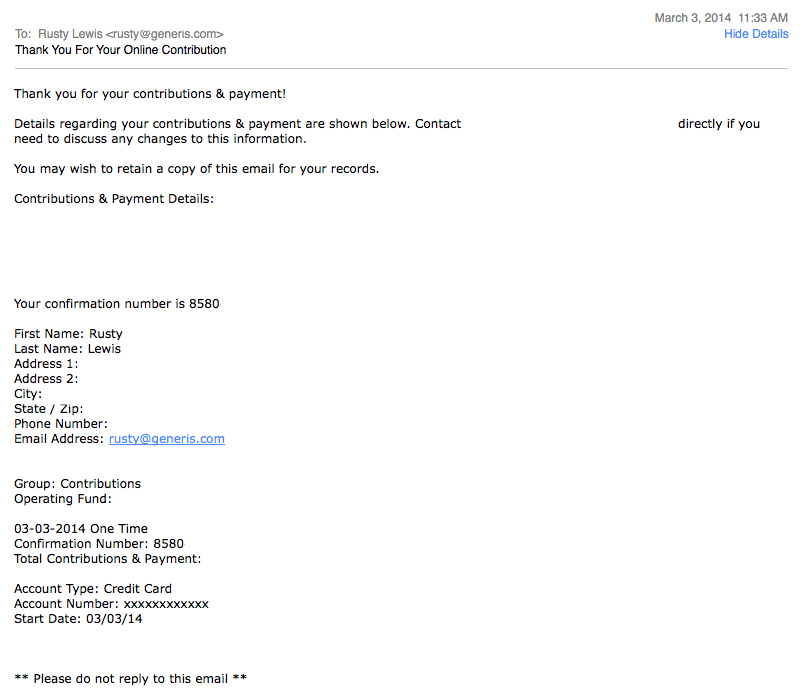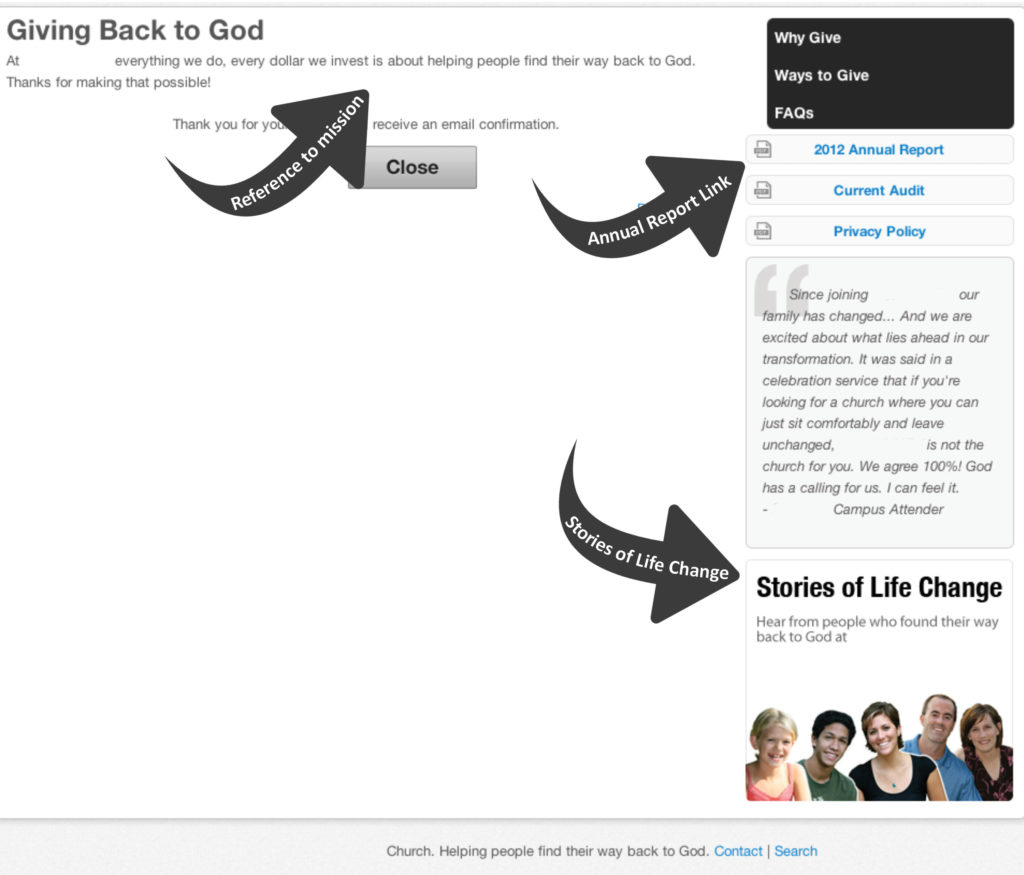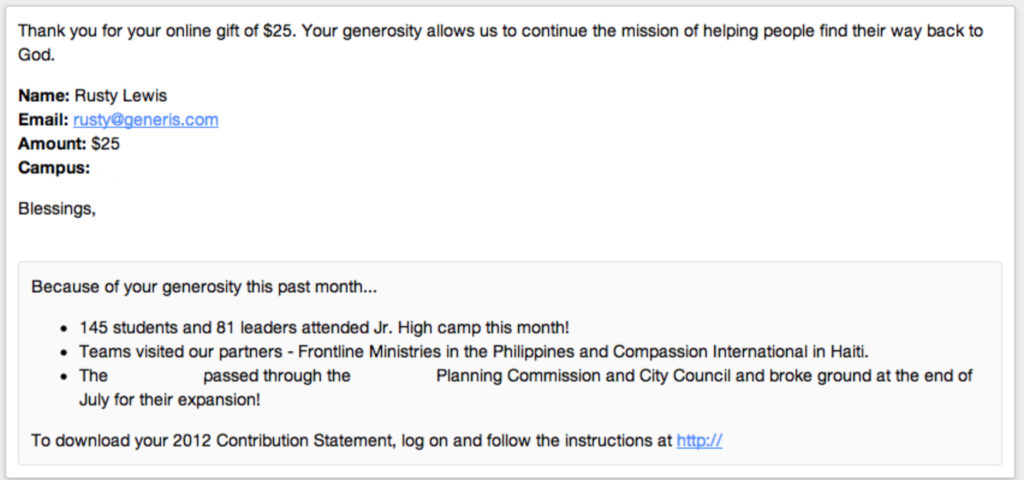Amazon.com??? I Thought I Just Contributed to My Church!
Technology“I give to places outside my church because I believe my money is used more effectively in other organizations.”
“Other nonprofits do more to solve a problem.”
“My generation wants to give to something that makes an impact.” (from a millennial)
“When it (money) goes into a ‘pot’ and I don’t know what it’s doing, I’m less likely to give. I want to give to people – it’s about visionary giving vs. needs-based giving.”
These are all real comments I’ve heard in a few recent Generosity Audit focus groups while interviewing various church attendees. These are actual quotes. (ouch!)
The good news is that many of these misconceptions could be solved with very simple and transparent communication after someone gives to your church. And the online giving experience is an opportunity for communication that often goes overlooked.
After someone gives to your church online, what do they see? What do they receive?
I test online giving systems as part of the Generosity Audit. When I hit “submit” to finalize my gift, I typically see a webpage confirming my gift. I usually receive an e-mail communicating the same thing, too. However, I’m often surprised at what I see. Here’s a perfect example of the webpage I see when I click the “submit” button:

Yep, that sure feels like I’m making a difference with my giving alright! Wow. Two exclamation points on the warning about clicking the back button?
This just feels too transactional to me, and I have not the faintest idea where my money might go and what it might do. I just know it’s gone from my bank account. (That was confirmed very clearly, wasn’t it?)
And what do I receive in my e-mail? Here’s a very typical example:

What’s wrong with this, you ask? It just feels so transactional … so sterile. I may as well have just completed a purchase for myself on Amazon.com. What’s missing is a direct connection between my gift and the church’s mission. How will my gift make a difference to someone else?
What SHOULD happen when one makes a gift online?
- A webpage should confirm the gift upon hitting the “submit” button. This webpage should say “thank you” first and foremost. It should also:
- confirm the amount of the gift.
- offer a link to allow the giver to create an account, allowing easier access for recurring gifts. (You were wise not to require an account to make the initial gift – I wrote about that previously.)
- go a step further and make a tie between the gift and the church’s ongoing mission. This is critical!
- An e-mail should arrive in the giver’s inbox within an hour of your receipt of the gift. This e-mail should repeat some of what they saw on the webpage, but that’s not all. This is something you are sending directly to the person who gave, so take full advantage of this opportunity!
- State your ministry’s mission and tell how the gift will enable you to better fulfill that mission.
- Share recent examples of ministry impact and how their gift makes future life change possible.
- Link to a recent baptism video or a story of life change video.
- Provide a link to their online giving statement, if you are making your giving statements available online.
- Link to your most recent annual report online. (You just completed one of those, right?)
- Share your ministry vision and goals to reach others in the community and around the world in the coming year.
- Invite the giver to continue in partnership with you and the church in order to make that vision a reality.
So what does this look like in action?
Here are some great examples:

Notice on the above webpage example there are several things I have recommended. First, there’s the reference back to the church’s mission. There’s a link to the annual report, and there’s also a place where you can read or watch stories of life change.
There’s no question, after going through all these features, that this church is doing great things with the generosity of those who give online.

This is the e-mail confirmation I received shortly after I gave online to this church. Again with the mission. (These guys are great about that … it’s so deeply rooted in their DNA, it’s on everything they do!) Then they offer three great examples of ministry impact the church has been able to accomplish through the generosity of the church.
It certainly gives the perception that they are stewarding well the gifts received. Do you see how this helps the giver sense that their giving is making a difference in the lives of others, rather than just going to fund the budget of the church?
What should you do now?
I recommend you go online right now and make two gifts: one to your church and one to the nonprofit of your choice. (Charity Water, Compassion International, Soles for Souls, World Vision … you pick!) Be sure to take screenshots or print what you see as you go through each step of your online giving experience. (Print the e-mail confirmation too!)
Now, take the screenshots and printouts to your next meeting with your communications or media team and rewrite your pages. Work with your webmaster and online giving provider to make the necessary changes.
I would be happy to review your drafts as you develop your webpages and e-mails. Just send them to me at rusty@generis.com.
Here’s the point: SHOW people what you’re doing with their generosity. Remove the guess work. Take away the question mark. Be transparent. After all, that will only encourage future generosity.
Done effectively, you will lessen the likelihood of hearing, “I give to places outside my church, because I believe my money is used more effectively in other organizations.”
Next, we will look at what the year-end giving experience should entail. In the meantime, how does your church share examples of ministry impact in your online giving experience? How do you tie generosity back to the mission of your church? I’d love to hear from you!

